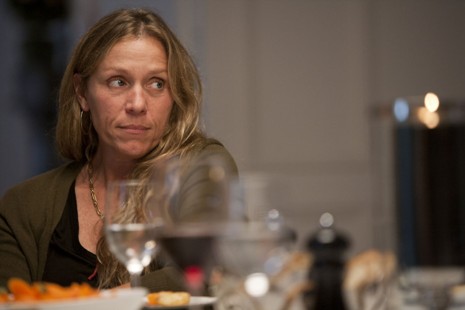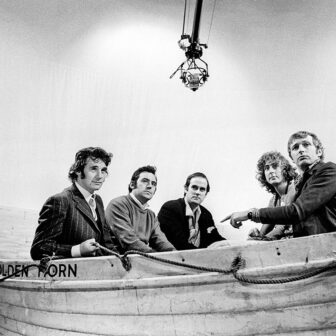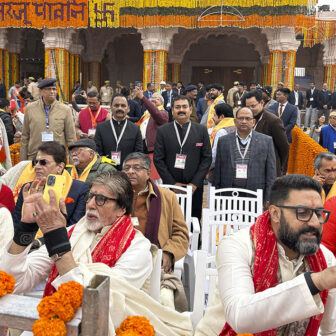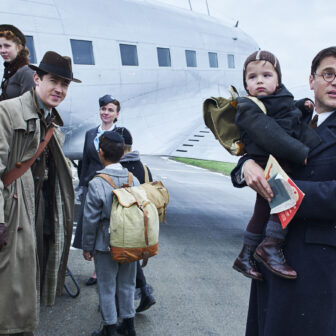THEY love it or they hate it; This Must Be the Place really divides audiences. Maybe they’ve gone in to see it because of David Byrne and Talking Heads, and then didn’t get enough of them, or because they thought Sean Penn in wig and makeup might be no more than off-the-wall camp entertainment. In any case the experience became properly uncomfortable, and some viewers, reviewers among them, have gone online to tell us that it’s a giant heap of garbage. They could find no way of bringing its elements together, and I’m not here to correct them; rather to suggest that the capacity of cinema to depart from naturalism, and present what’s grotesque, incoherent, apparently non-sequential, is one major reason to pursue it.
So you’ve got a road movie, and the agent of the quest is not your floundering, well-intentioned innocent who has lost a father, but a has-been rock star leading a near-impossible, almost deadened after-life. Inside the huge wig, from the face masked with lipstick and mascara, Sean Penn as Cheyenne delivers monotone lines. From the beginning in Dublin, in a seemingly normal domestic space with a sane and knowing wife – played very sanely and knowingly by Frances McDormand – he sets out to find the father he hasn’t seen or spoken to in decades. Reaching the bedside just too late, he sees the numbers from the man’s time in a concentration camp, and sets out to find the Nazi torturer. From there, we get a gallery of American grotesques, and landscapes which are horrific because they’re like reality, just slightly skewed. Getting across the Midwest – all lonely gas stations, endless roads running to flat horizons – This Must Be the Place looks more than a bit like Paris, Texas, the more so with the brief and highly enjoyable appearance of Harry Dean Stanton. This film, like Wim Wenders’s of 1984, presents an America seen from Europe, with the difference that the Europe of the director Paolo Sorrentino, and his co-writer Umberto Contarello, is one that remembers the Holocaust – though whether Cheyenne’s pursuit really needed the concentration camp images is a point to be argued.
In this film, plot isn’t really a consideration. There is an array of visions, pictures from a journey, and a return home. The film poses a major question; after hitting a rock star’s apex, how does anyone come down? “You sang with Mick Jagger,” says the child. “No,” says Cheyenne, “I didn’t sing with Mick Jagger, he sang with me.” If Cheyenne seems permanently stoned, it’s because he is, not with any particular substance but because the way back down into ordinariness has been unendurable, for all of them (consider again those high celebrity deaths). Frances McDormand’s performance, in this film as in others, has to do with getting back into some kind of real world. There’s a film that shadows this one, lurking behind it, and it’s hers.
Le Havre has been widely accepted as a benign, sweet-tempered entertainment from the travelling Finnish director Aki Kaurismäki; “utopian,” as the Village Voice critic J. Hoberman wrote, because it shows “everything as it is not.” Indeed; the people of the working-class community around the docks in the port city are kindly and seasoned; they respond to human need when they see it, and nobody thinks the pathetic black folks who are found inside the ship’s container should go back to where they came from. The elderly shoeshine man will go many miles out of his way to connect the wandering twelve-year-old Idrissa with his lost African family; the community will cheerfully organise a fund-raising pop concert to buy Idrissa’s smuggled passage to London, where his mother, herself sans papiers, is working in a laundry. There will be hope, if not quite a happy ending; and the film, superbly performed by its ensemble, convincingly projects a locale and a milieu. Since all films must be considered in their contexts of reception, Le Havre is as much a moral fairytale for ourselves as for any other grudging Western movie-consuming area it may land in. I see it not long after reading about the most recent suicide in Villawood.
THE Film Critics’ Circle of Australia issued its judgements in April. I think they’re right in confining the field, and their own role, to Australian films – there are enough awards for the rest; and I can see the merit in this year’s judgements: best film, best direction and best actor awards all went to Snowtown, its director Justin Kurzel and lead Daniel Henshall. Emily Watson was judged best actress for her work in Oranges and Sunshine. I was sorry to see that the only recognition for Ivan Sen’s Toomelah was the award to Daniel Connors for the best work by a young actor, much as that was deserved; and more regretful that the FCCA doesn’t reach toward documentary, given that The Hungry Tide, The Tall Man and Mrs Carey’s Concert must be, on any measure, among the best films to emerge through the year. It would also be an excellent thing, in this anti-critical climate, if the FCCA could expound and publish their criteria. •





